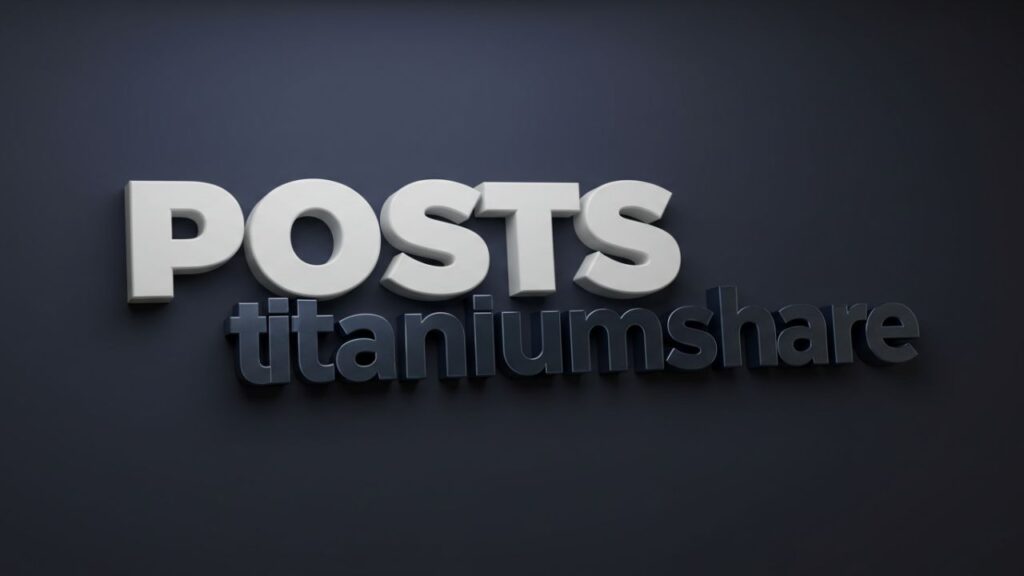Introduction
In an era where digital content oversaturation is the real challenge, posts titaniumshare emerge as an intriguing alternative approach to how creators publish, share, and manage their work. Rather than relying on crowded social media feeds or generic blogging platforms, posts TitaniumShare offer a more intentional, controllable, and streamlined environment. In this article, we’ll dive deep into what posts titaniumshare means, how it works, what benefits and challenges it brings, and how creators can leverage it today.
What Are Posts TitaniumShare?
Concept & Definition
The term posts titaniumshare refers to content units (articles, images, multimedia) published via the TitaniumShare system. This isn’t simply another sharing tool — each post is treated as a discrete, managed object with metadata, permissions, and distribution logic behind it.
TitaniumShare positions itself as more than a file sharing or blogging platform; rather, it blends elements of content publishing, secure sharing, and creator autonomy.
Core Design Principles
-
Ownership and Provenance: Each post carries identity metadata and tracking to preserve authorship
-
Permission Controls & Licensing: Authors decide who can view, who can share, and under what conditions.
-
Decentralized / Secure Foundations: Some implementations point to distributed storage, encryption, or blockchain‑adjacent systems as part of the architecture
-
Separation from Algorithmic Noise: Instead of fighting for algorithmic attention, posts titaniumshare are meant to find audiences via relevance, community, and quality rather than viral mechanics.
In short: a posts titaniumshare is not just a piece of content — it’s a managed, intentional, shareable unit in a controlled ecosystem.
How Posts TitaniumShare Work (Underlying Mechanics)
Metadata & Structure
Under the hood, each posts titaniumshare entry may consist of several layers:
-
Metadata Layer: author, timestamp, unique hash or ID, license/permission flags
-
Content Layer: the actual text, images, or embedded media
-
Distribution / Access Layer: rules about who sees it, who can repost, whether tipping or payment is involved
This modular structure allows fine control over visibility and rights.
Sharing & Linking
When you publish a posts titaniumshare, you often obtain a shareable link, or embed code, through which readers access the content. The platform enforces the permissions set by the author.
In some scenarios, posts may also be partially public, partially gated (e.g. premium content), or viewable only to specific groups.
Monetization & Incentives
Unlike many social platforms that monetize creators indirectly, posts titaniumshare often come with built‑in support (or at least potential) for tipping, micropayments, or gated premium content. Creators can set price tiers, subscription access, or reward structures.
This gives more direct control over monetization without depending fully on ad revenue or sponsorships.
Key Benefits of Publishing Posts TitaniumShare
1. Creator Control & Independence
You’re not bound by algorithmic visibility or ever‑changing platform rules. Posts titaniumshare give you more control over who sees your content, how it’s distributed, and under what terms.
2. Security & Ownership
With proper implementation, posts are less vulnerable to platform takedowns, censorship, or content loss. Because authorship metadata is embedded, the provenance is preserved.
3. Monetization Flexibility
You can monetize directly—via paywalls, subscriptions, or tipping—without depending solely on third-party ad networks. This helps creators build sustainable income models.
4. Lower Noise, More Intentional Reach
Because the system de-emphasizes virality mechanics, your content has a chance to be seen by genuinely interested audiences. That helps improve quality over quantity.
Challenges & Limitations
Discoverability & Reach
Without algorithmic boosts, gaining visibility can be slower. Effective outreach, SEO, and community curation become more essential.
Technical Complexity
Systems that incorporate decentralized storage, encryption, or licensing layers may introduce onboarding friction for less technical users.
Content Moderation & Governance
In a decentralized or semi-decentralized setup, judging what is acceptable content and policing misuse becomes trickier. Governance models must evolve.
Maintenance Overhead
Managing versions, updating permissions, and ensuring content stays fresh or relevant adds workload. Authors may find themselves maintaining posts as ongoing projects, not one‑off publications.
Best Practices to Get the Most Out of Posts TitaniumShare
Use Compelling Hooks Early
Because users may skim, the first few lines of your posts titaniumshare should grab attention — pose a question, share a compelling stat, or tell a micro‑story.
Structure with Clarity
Use headings, subheadings, bullets, and short paragraphs. This helps readability, especially on mobile.
Embed Media Thoughtfully
Visuals, diagrams, or short video clips can enhance comprehension and break monotony. Ensure they align with your topic and reinforce, rather than detract.
Set Clear Permissions & Monetization Options
Decide upfront whether your content is free, partially gated, or premium. Use permissions smartly — e.g., free preview, paid full access, or comments-only view.
Promote & Cross‑Link
Since posts titaniumshare may not have built-in massive reach, promote your posts via social media, email newsletters, or partner sites. Use cross-links between posts to retain users.
Encourage Engagement
At the end of your post, ask readers questions, invite feedback, or call to action. This helps community growth and visibility.
Use Cases & Real‑World Scenarios
Independent Writers & Essayists
For writers tired of platform algorithms de‑prioritizing longform, posts titaniumshare offer a space to publish essays that maintain control and integrity.
Niche Educators & Course Creators
Course creators can release mini‑modules or premium lessons via posts, controlling who accesses what while preserving ownership.
Researchers & Open Knowledge Builders
Academics or researchers can publish findings, data sets, or commentary in a format that respects provenance and encourages peer engagement.
Visual & Multimedia Creators
Photographers, illustrators, and multimedia artists can use posts titaniumshare to package work with licensing rules, previews, or selective sharing.
Technical or Tutorial Authors
Coders, devs, or tech educators can publish detailed tutorials with versioning, gated advanced appendices, or tip/donate options.
Future Directions for Posts TitaniumShare
As the concept grows, we might expect:
-
Localized / Thematic Hubs: Subcommunities by region, topic, or language.
-
AI Assistance: Smart drafting, image suggestions, or content summaries to help creators.
-
Interoperability with Web3 / Decentralized Apps: Bridging with NFT-style content licensing, decentralized identity, or tokenized communities.
-
Enhanced Analytics & Insights: Better feedback loops to help creators understand engagement, read times, drop-off points.
-
Collaborative Posts & Version Trees: Posts as evolving documents, with tracked forks, collaborative amendments, or reader contributions.
Conclusion
The rise of posts titaniumshare signals a shift in how we think about publishing and content ownership. As mainstream platforms grow noisier and more controlled, creators are looking for spaces where they can retain authority, structure monetization on their own terms, and foster deeper connection with their audience. Though challenges like discoverability and complexity exist, the benefits of independence, clarity, and control make posts titaniumshare a compelling option for modern digital creators.
If you like, I can also craft sample post templates, SEO checklists, or a content plan specifically for TitaniumShare. Would you like me to build that next?





